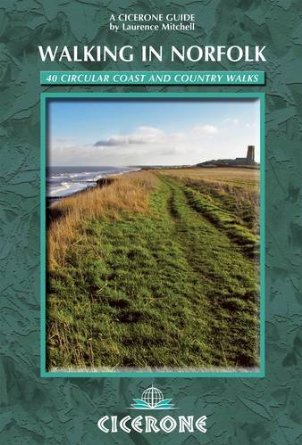My new Cicerone walking guide, Walking in Norfolk is going to be published in a week or two’s time and so here is a small taster of what to expect. The book contains 40 circular walks in all, and covers all parts of the county from northeast Norfolk to the Waveney Valley to the Fens.
Here’s a bit from the Introduction:
‘Very flat, Norfolk’, asserts Amanda in Noël Coward’s Private Lives, reflecting pretty much the commonly held view of the county: a place, with attitude perhaps (think of its heroes – Horatio Nelson, Thomas Paine, Delia Smith, Stephen Fry…Alan Partridge), but certainly not with altitude. The stereotyped view, although misleading, is understandable enough, as most people have some sort of image of Norfolk even if they have never visited the county. Many will have seen the vast sandy expanse of North Norfolk’s Holkham Beach in films like Shakespeare in Love or TV programmes like Stephen Fry’s Kingdom. Many more will think of boating holidays on the Norfolk Broads, or make associations with the low-lying Fenland region of the far west of the county: aspects of Norfolk, certainly, but not the full picture by any means.
…and here’s a snippet from Walk 10: Burgh St Peter and ‘The Triangle’:
 ‘The Triangle’ is a local name that was sometimes used to refer to the parishes of Aldeby, Wheatacre and Burgh St Peter in southeast Norfolk. Bound on two sides by a bend of the River Waveney and on the other by the now-dismantled Beccles to Great Yarmouth railway, the triangle of land so defined has something of the feel of an island to it. There is no through road here, just a quiet single-track lane that links the farmsteads on the marshland edge. To the north, east and south a large flat area of marshes lies between the relatively high land of ‘The Triangle’ and the river itself.
‘The Triangle’ is a local name that was sometimes used to refer to the parishes of Aldeby, Wheatacre and Burgh St Peter in southeast Norfolk. Bound on two sides by a bend of the River Waveney and on the other by the now-dismantled Beccles to Great Yarmouth railway, the triangle of land so defined has something of the feel of an island to it. There is no through road here, just a quiet single-track lane that links the farmsteads on the marshland edge. To the north, east and south a large flat area of marshes lies between the relatively high land of ‘The Triangle’ and the river itself.
 Burgh St Peter’s Church of St Mary the Virgin is one of Norfolk’s oddest churches as its tower is in the form of a five-section ziggurat (or, as some have fancied, a collapsible square telescope). The body of the church dates from the 13th century but the tower is an 18th-century addition, supposedly inspired by the Italian travels of William Boycott, the rector’s son. A dynasty of Boycotts served the church for a continuous period of 135 years and Charles Cunningham Boycott, the son of the second Boycott rector, gave the term ‘boycott’ to the English language when he behaved badly over absentee rents in Ireland and was socially ostracised as a result.
Burgh St Peter’s Church of St Mary the Virgin is one of Norfolk’s oddest churches as its tower is in the form of a five-section ziggurat (or, as some have fancied, a collapsible square telescope). The body of the church dates from the 13th century but the tower is an 18th-century addition, supposedly inspired by the Italian travels of William Boycott, the rector’s son. A dynasty of Boycotts served the church for a continuous period of 135 years and Charles Cunningham Boycott, the son of the second Boycott rector, gave the term ‘boycott’ to the English language when he behaved badly over absentee rents in Ireland and was socially ostracised as a result.


Looking forward to seeing a copy of this, good stuff!
Thanks, Martin. There’s a bit more on the Cicerone blog: http://www.cicerone.co.uk/blog/index.php/2013/11/walking-in-norfolk/.
Well, that’s really good news, congratulations, Laurence! I just visitied the Cicerone blog. It’s looks like a great book, I’d like to get it. I’m currently in Cley next the sea. We’re thinking of a daytrip to Norwich within the next week or so; will the book be out by then? Can I buy a signed copy anywhere, I wonder? Or maybe we could meet for a cup of tea or a pint 🙂 and you’ll sign it?
Wishing you all the best and lot of happy walkers buying your book.
Dina
Hi Dina. Thank you very much. I don’t have any copies of the book myself yet but I expect that I will have some within the next week or two. I don’t know if the book is in the shops yet – it is certainly at the warehouse now. If you come to Norwich it would be good to meet up – best to contact me by direct email perhaps? Details are here: http://www.laurencemitchell.com/contactform.html.
Laurence
I am looking foreward to your guide. As I live on the North Norfolk coast I will get my walking boots out and follow your advise.
Thank you!
Greetings from Cley next the Sea
Klausbernd
Bought the book today, looking forward to getting stuck in, good stuff, cheers!
That’s great, Martin. Thanks for buying it. I hope that you find it useful although obviously you aready know the county pretty well already.
I know west Norfolk and the coast but the interior is unknown territory for me. I’m planning to walk the Boudicca Way later in the year with a wild camp along the way : )
First walk completed from your book, and very enjoyable it was: http://martinblack.com/2014/07/on-the-nar-valley-way-a-norfolk-river-walk/
Many thanks, Martin. Glad that you enjoyed the walk.